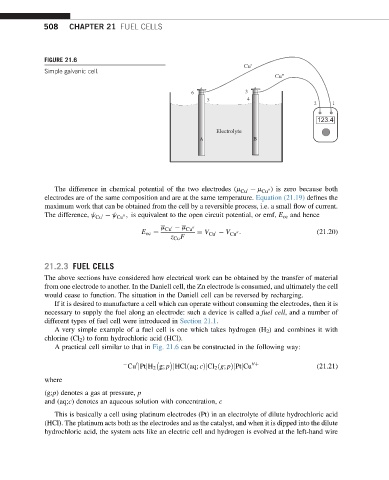Page 515 - Advanced thermodynamics for engineers
P. 515
508 CHAPTER 21 FUEL CELLS
FIGURE 21.6
Cu'
Simple galvanic cell.
Cu''
6 3
5 4
2 1
123.4
Electrolyte
A B
The difference in chemical potential of the two electrodes (m Cu 0 m Cu 00) is zero because both
electrodes are of the same composition and are at the same temperature. Equation (21.19) defines the
maximum work that can be obtained from the cell by a reversible process, i.e. a small flow of current.
The difference, j Cu 0 j Cu 00; is equivalent to the open circuit potential, or emf, E oc and hence
m Cu 0 m Cu 00
E oc ¼ ¼ V Cu 0 V Cu 00: (21.20)
z Cu F
21.2.3 FUEL CELLS
The above sections have considered how electrical work can be obtained by the transfer of material
from one electrode to another. In the Daniell cell, the Zn electrode is consumed, and ultimately the cell
would cease to function. The situation in the Daniell cell can be reversed by recharging.
If it is desired to manufacture a cell which can operate without consuming the electrodes, then it is
necessary to supply the fuel along an electrode: such a device is called a fuel cell, and a number of
different types of fuel cell were introduced in Section 21.1.
A very simple example of a fuel cell is one which takes hydrogen (H 2 ) and combines it with
chlorine (Cl 2 ) to form hydrochloric acid (HCl).
A practical cell similar to that in Fig. 21.6 can be constructed in the following way:
0 00þ
Cu jPtjH 2 g; p jHClðaq; cÞjCl 2 ðg; pÞjPtjCu (21.21)
where
(g;p) denotes a gas at pressure, p
and (aq;c) denotes an aqueous solution with concentration, c
This is basically a cell using platinum electrodes (Pt) in an electrolyte of dilute hydrochloric acid
(HCl). The platinum acts both as the electrodes and as the catalyst, and when it is dipped into the dilute
hydrochloric acid, the system acts like an electric cell and hydrogen is evolved at the left-hand wire

